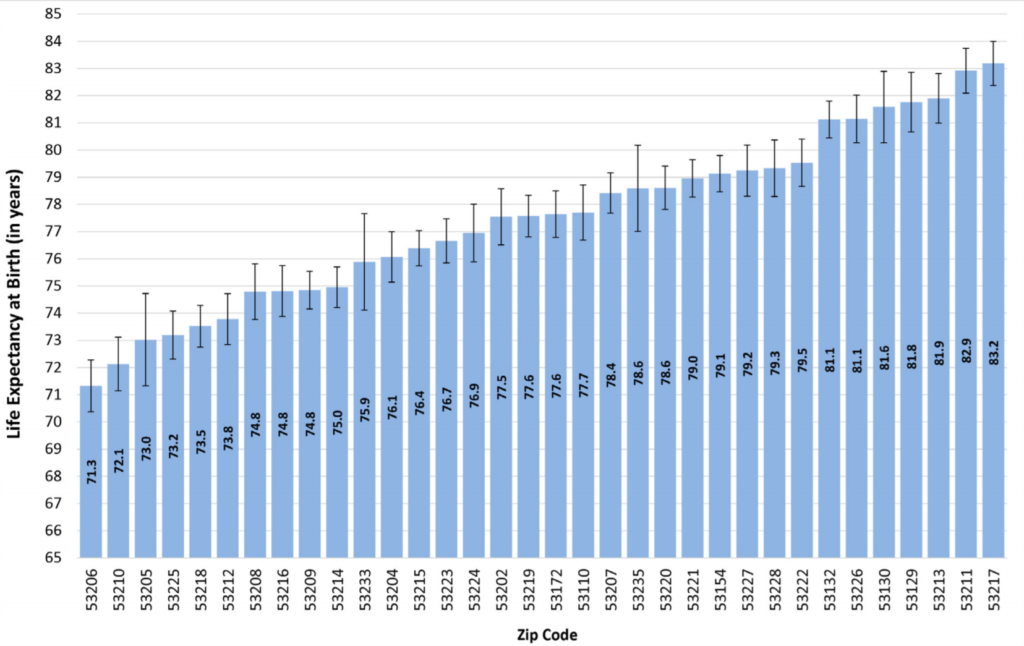Health
Milwaukee has vast differences in health outcomes across zip codes, which correspond with racial segregation.
10.8% of children in Milwaukee have elevated lead levels in their blood, and half of these children are Black.
(Source: Wisconsin Department of Health & Human Services, 2016)
Alcohol liver disease death rates are six times higher for the American Indian population than any other population in Wisconsin.
(Source: Wisconsin State Assessment and Health Improvement Plan, 2017)
In 2019, Milwaukee County declared racism a public health crisis. The resolution was created to increase urgency and accountability around addressing racial inequity in health.
Racial disparities exist in health care access, disease prevention, identification of disease, treatment, care coordination, outcomes, patient satisfaction, and more. African Americans, Hispanics, American Indians, and Alaska Natives all have higher rates than whites of many of the deadliest diseases, such as stroke and type 2 diabetes, and higher mortality rates (Centers for Disease Control and Prevention 2017; Spanakis and Golden 2013). A wide range of factors contribute to these disparities, including access to high quality care, access to early screenings, the nature of patient-provider relationships, class inequality, and environmental racism. There are strong correlations between life expectancy and median household income, educational attainment of a bachelor’s degree or higher and the socioeconomic index combining education and income.
Today’s health disparities have been significantly shaped by historical patterns of White privilege and White supremacy.
Modern medical practices in the U.S. developed during the era of slavery, and they were shaped and reinforced by the broader culture of racism. Slaves were frequently used for medical experimentation. Scientific arguments enforced and perpetuated justifications for racism, many of which continue to be perpetuated through racial stereotypes. Science was used to argue that race is a biological reality rather than a social construct. Social Darwinism and the eugenics movement perpetuated beliefs that people of color and people in poverty were incapable of high moral and physical standards, whereas the white race was pure and fit for survival. After the Civil War, southern physicians argued that blacks were pathologically different from whites, which was used to justify Jim Crow laws and to exclude blacks from white medical institutions. There are many examples of resistance to health inequities. For example, African Americans developed their own health care schools and systems in response to their exclusion from segregated institutions. Modern medicine also displaced traditional methods of healing in many cultures, as medical practice became defined as the province of physicians who graduated from medical schools, which limited admission to white men.
Neighborhood health matters. The life expectancy of children born into the 53217 zip code is 83.2 years, but 71.3 years in the 53206 zip code. 89.4% of 53217 residents are white, 76.1% have a bachelor’s degree or higher, and the median household income is $97,690). 93.6% of 53206 residents are black, 21.6% have a bachelor’s degree or higher, and the median household income is $22,468.
(Source: E.S. LeCounte & G. R. Swain, Life Expectancy at Birth in Milwaukee County: A Zip Code-Level Analysis, 2017)

Learn More
- City of Milwaukee, Community Health Improvement Plan (2017-2022)
- E.S. LeCounte & G. R. Swain, Life Expectancy at Birth in Milwaukee County: A Zip Code-Level Analysis (2017)
- Milwaukee County, Community Health Needs Assessment, Key Informant Report (2018-2019)
- Milwaukee County, Community Health Survey Report (2018)
- Wisconsin Department of Health Services, Wisconsin State Health Assessment and Health Improvement Plan (2017)
- Wisconsin Public Health Association Resolution: Racism is a Public Health Crisis (adopted May 22, 2018)
Organizations Involved in this Work
See Get Connected: Health Equity and Wellness to locate local organizations working to create equitable health outcomes.
Take Action
Stay tuned for more ways to take action! Are you part of an organization or group that is seeking volunteers to take action on this issue? Let us know at ridracism@gmail.com so we can list your efforts on this page.
